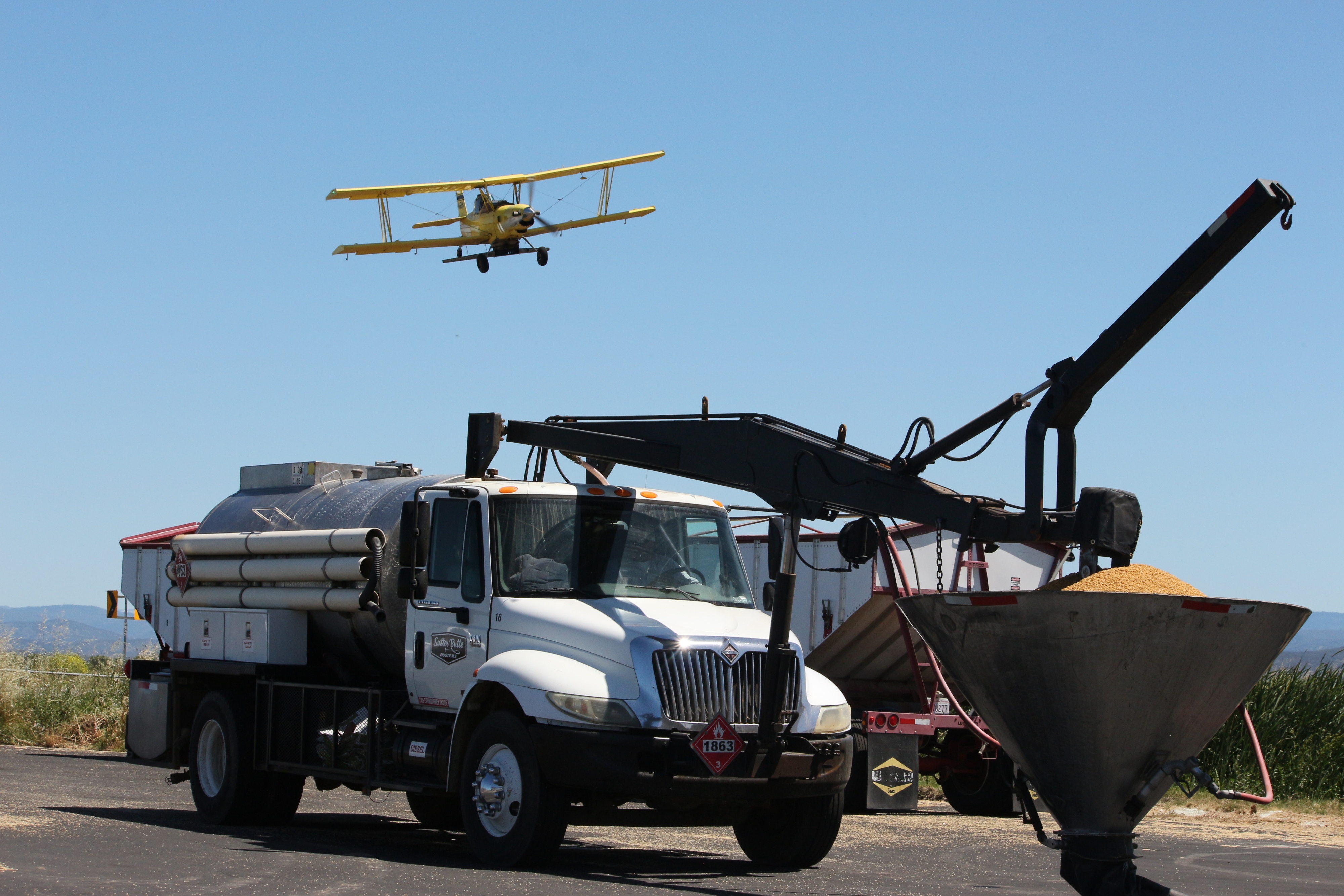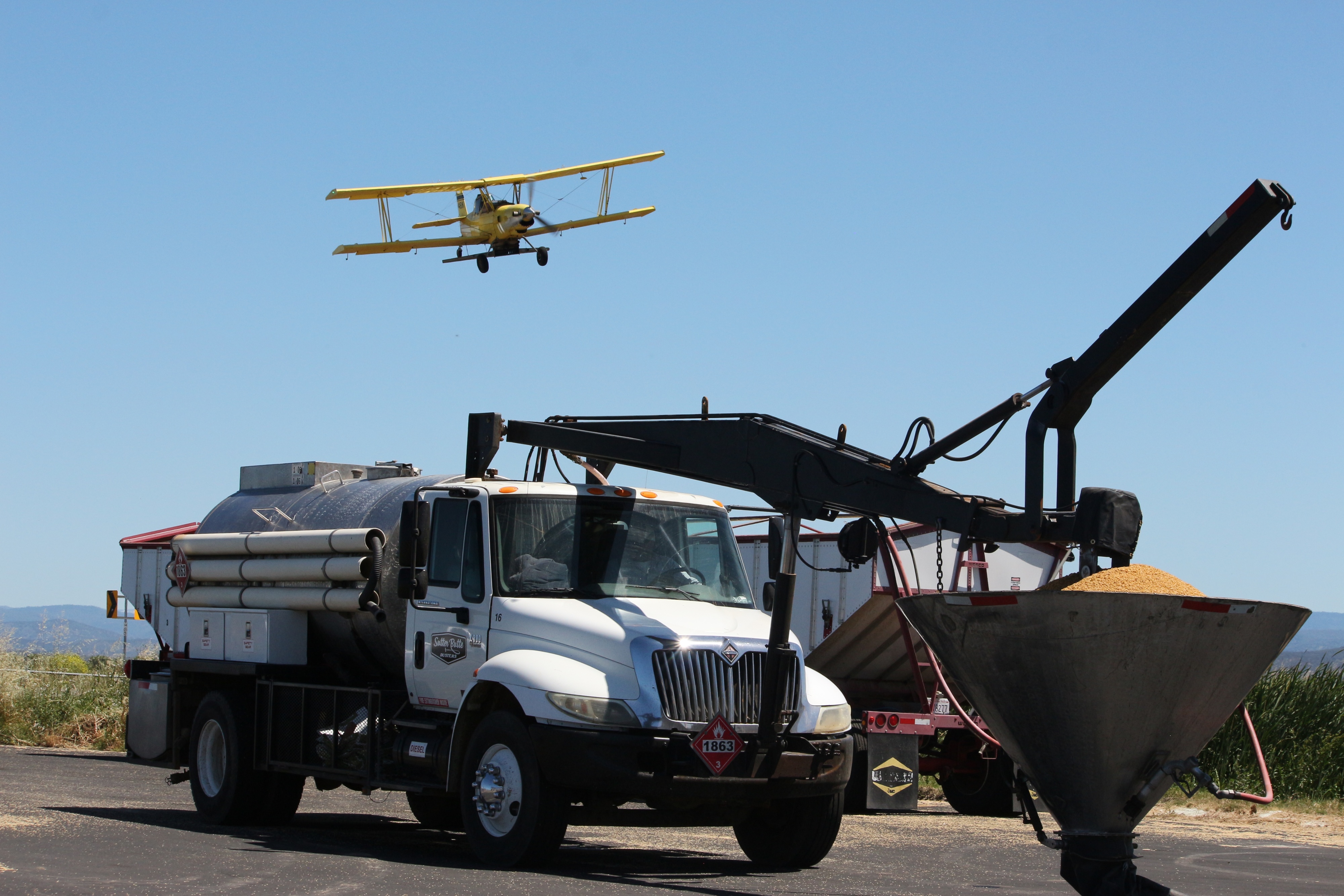Rice planting ramps up after slower start

While planting a rice field in Yuba County, an agricultural aircraft operated by Sutter Butte Dusters in Live Oak flies back to the landing strip to refill with rice seed. Aided by summer-like temperatures last week, rice growers throughout the Sacramento Valley raced to get fields prepared and planted.
Photo/Ching Lee

By Ching Lee
After a storm dumped more than an inch of water on parts of Northern California earlier this month, effectively halting fieldwork, rice farmers have since been going full throttle.
Throughout the Sacramento Valley, aerial applicators can be seen crisscrossing the skies raining rice seed onto flooded fields while tractors prepare neighboring plots for planting. Strong winds grounded planes for a day last week, but farmers say the gusts and subsequent higher temperatures have helped to dry out fields to allow tractor work.
With the region receiving full water allocations, most rice farmers say they intend to plant all their acreage, weather permitting. Knowing the final acreage count will influence market prices, which have fallen after the 2023 harvest brought decent yields from increased plantings, said Yuba County grower Charley Mathews Jr.
“We’re going to have a reduction (in acreage) definitely, but you never know until everybody’s planted,” he said.
Before the storm, California growers were projected to sow 497,000 acres of rice this year, according to the U.S. Department of Agriculture prospective plantings report in March. That’s down from 515,000 acres last year but much more than 2022, when plantings plunged to 254,000 acres—the state’s lowest since 1958—due to impacts of drought and reduced water deliveries.
The wet spring has brought its share of challenges. With 10% of his fields planted as of last week, Butte County grower Josh Sheppard said rainy conditions throughout the season have put him behind schedule. The recent storm further slowed his momentum. Another major rain event could prevent him from planting all his ground, he said, the remainder of which are heavier soils that do not dry as quickly.
“It’s not like we haven’t been here before. Rain tends to happen every spring and interrupts planting most years,” Sheppard said, though he noted growers are more accustomed to little showers that may stop work for a day, not this month’s deluge that set him back a week.
Those who farm in the floodplains of Yolo and Sutter bypasses face similar challenges but with an added concern: warm weather and snowmelt inundating already-swollen Shasta and Oroville dams, necessitating water releases that could further flood saturated fields.
For growers in South Sutter Water District—which serves more than 200 landowners in Yuba, Sutter and Placer counties—the issue is reduced water supplies due to a flume failure, which could prevent some acres from being planted. It remains unclear if repairs will be done in time to allow more water for affected growers.
With so many farmers racing to flood their fields to begin seeding, some water districts may not have the capacity to service them at the same time. Colusa County grower Chris Torres said he received a notification from the Glenn-Colusa Irrigation District last week saying it will be rationing and flooding fields one at a time.
Rice farmers aim to finish planting by June 1, after which is considered risky because it pushes harvest into the rainy season. Rain during harvest can cause lodging, or the plants to fall over, leading to yield loss. June 1 also serves as a deadline for those with crop insurance who plan to seek compensation for prevented planting.
With lower prices currently “the talk of the coffee shop,” Torres said, taking crop insurance for prevented planting would not be a bad option this year because payment would be calculated based on the 2022 crop price, which soared due to the reduced acreage.
“Given the rice prices that we’re looking at and the benefits of insurance, there might be some guys dragging their feet a little bit,” said Mike DeWit, who has fields in the Sutter Bypass.
Even though this month’s storm put him behind schedule, DeWit said he plans to finish planting before June 1, noting he was in the final stages of ground preparation last week. For acres in the bypass, he typically grows an earlier-maturing variety.
Despite the depressed market, DeWit said he thinks rice acreage will end up being similar to last year’s because of fewer contracts for sunflowers. In the Sutter Basin near Robbins, he noted, growers requested seed for 47,000 acres of rice, a historic high for that area.
After so much fallowing in 2022, DeWit said growers have been eager to farm, especially if they lease land. But he also lamented that the current oversupply of rice has not been good for the market.
“It wouldn’t hurt my feelings at all if more acreage was left out,” he said.
Not being able to ship rice to the Middle East due to conflicts in the Red Sea region has been problematic, said Yuba County’s Mathews, who serves as board chairman of Farmers’ Rice Cooperative.
Middle Eastern buyers tend to be more price-sensitive and have not been buying rice from California because of the higher price. Now that prices have softened, “there’s big demand,” he said, but they continue to buy from Russia, which is closer in proximity and doesn’t have shipping constraints.
China, the world’s second-largest importer of rice, also has not been buying California rice after it imported its first-ever U.S. commercial rice shipment from a California company in 2019. The purchase was considered a turning point, as the U.S. rice industry had worked for more than a decade to gain access to the Chinese market. A U.S.-China agreement in 2017 opened the market for American rice, but strained trade relations remain a stumbling block.
“We’ve been working years and years trying to get some markets established (in China), but we’ve sent very little over there,” Mathews said, noting China has its own production and not much demand.
California’s traditional export destinations for rice, such as Japan and South Korea, “remain fine,” Mathews said. Domestic sales also have been “pretty good,” he added, though they’ve fallen since the pandemic spike.
The market outlook for the 2024 crop could improve depending on what happens to the balance of the 2023 crop, Mathews said, adding, “If we can get some into the Middle East, that helps a great deal.”
Butte County’s Sheppard said growers have operated on thin margins before, pointing to the cyclical nature of farming and commodity markets.
“We still want to plant rice because that’s what feeds the local economy,” he said. “It’s important that we have the planes flying, the fertilizer manufacturers and the mills that process our rice. This industry needs a critical volume of activity to support all the infrastructure that’s in place.”
(Ching Lee is an assistant editor of Ag Alert. She may be contacted at clee@cfbf.com.)




